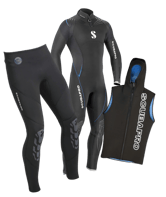From Beginner to Advanced
Conquering Buoyancy and Cold Waters in My A-Course Journey


The Start of My A-Course Adventure
Fast forward a few months, and it’s like I took the O-course just for funsies. Now suddenly, I’ve got to gear up for a fun dive—not locally, oh no, but out of the country! And, of course, to depths I’m definitely not certified for. So here I am, texting Allen like, “Hey, can we get me started on the Advanced Course ASAP?”
The real kicker? I’ve forgotten most of what I learned in the O-course. I mean, come on—would you honestly remember everything you crammed into two days, five months later? Yeah, me neither.
So, I meet up with Allen again—the same instructor I mentioned last time. At this point, he’s becoming my go-to dive guy. He’s got way more experience and qualifications than I can even list, so I’m in good hands. Naturally, the first thing I do is confess that I’ve forgotten most of what we covered in the O-course. I mean, I remember the absolute basics: setting up the tank with the BCD, checking my gear, doing a giant stride entry… and, uh, yeah, that’s about it. Oh, and the hand signals? Completely wiped from my memory.
Luckily, I wasn’t the only one in this boat (pun intended). Allen paired me up with a buddy who was in exactly the same situation. (Seriously, don’t worry about not having friends in diving—just be willing to reach out, and you’ll always find a buddy.)
The entire boat ride to our lesson was basically a mutual “what do you remember?” session. We kept chatting, piecing together our fragmented memories, and bugging the instructors with questions about everything we forgot. It was honestly kind of comforting knowing I wasn’t the only one feeling like a total beginner again.
Cold Weather, Layers of Wetsuits, and Buoyancy Struggles
This time around, you’d think it would all go smoothly, right? Nope! Not even close. See, we had to hop on a plane and do our fun dive just two weeks after finishing our lessons. That meant we absolutely had to complete our course without any hiccups. But of course, Mother Nature had other plans.
The weather in Hong Kong was not exactly beginner-friendly—it was cold. We’re talking 16-17°C at the surface, which drops to around 13-14°C once you’re at the required depth for our lesson. And that, my friends, is where our first challenge came into play. (Actually, it was our only real challenge, but it was a big one!) Dealing with the cold.
And to deal with that, we had to rely on wetsuits. Layers of wetsuits. (Why? Because it’s rental gear! Again!) I ended up wearing two or three pieces, stacking up to roughly 10mm of thickness between me and the water. Even with 24 pounds of weight strapped to me, I still couldn’t sink!
Now, let me tell you, putting on that many wetsuit layers was a workout all on its own. But once we were geared up and mentally prepared, we approached the dive like it was just another day in the water. Or at least, that was the plan.
The reality? No matter what I tried, I just couldn’t get down! I made multiple attempts, trying different techniques, almost to the point of holding my breath—which, for the record, you’re absolutely NOT supposed to do. (But come on, give me some slack—any beginner would’ve done the same in my situation, right? That’s why I’m writing this, to save you from my mistakes!)
Eventually, Allen noticed my struggle and came back up to check on me. It didn’t take long for him to figure out the issue: I was way too buoyant to get down. It took about 10 minutes of effort (and maybe holding my breath for a teeny bit, oops), but I finally managed to force myself all the way down.








Tackling Trim Position: My Biggest Challenge
After finally managing to dive down to the required depth, we got started on my lesson. At first, I was cruising through the tasks like a pro. Everything felt smooth, and I was starting to feel pretty good about myself. Then we hit the hardest part of the lesson: buoyancy control, specifically the trim position.
Now, if you’ve never done it before, let me tell you—it’s harder than it looks, especially with a strong current working against you and my overly buoyant self refusing to cooperate. Try as I might, I just couldn’t get my fins flat. No matter what adjustments I made, it felt like the water had its own plans, and I wasn’t part of them.
And… well, that’s it. There’s no happy ending here, unfortunately. By the end of the day, I still couldn’t nail the trim position. Going from breezing through tasks to getting stuck like that? It hit me harder than I expected. I couldn’t help but feel a little down, wondering if maybe I just wasn’t cut out for diving after all.
Once we got back on the boat, the conversation naturally shifted to my trim position—or lack thereof. I started bombarding Allen with questions: How long does it usually take for other students to get this right? What happens if I can’t nail it by the end of day two? Will I still pass and get certified?
Allen must’ve noticed the nervous energy radiating off me because he quickly stepped in to reassure me. He explained that it’s totally normal to struggle with this in the beginning. While I hadn’t fully mastered the form, I was about 80% there, which, given the circumstances, was considered pretty darn good.
Just as I started to feel slightly better, a couple of other instructors chimed in to back him up. They even pointed out something I hadn’t noticed: my weight belt had been sliding around the entire time because I was so buoyant! Sliding left and right like it had a mind of its own! They reassured me that once I got back to a normal buoyancy level, everything would fall into place.
Day 2: A Turnaround Success
Skipping ahead to the next day, the weather was way more bearable. I decided to ditch one of my wetsuits and stick with a single 5mm suit and around 12lbs of weight. What a difference it made! Descending was so much easier, and I could actually control my movements this time.
After a quick warm-up repeating some of the motions from the previous day, I finally nailed it—I got into trim position! Let me tell you, the satisfaction was real.
On the return boat ride, Allen reassured me that I’d be just fine. He reminded me that trim position and buoyancy control aren’t rocket science; they just take consistent practice. And honestly, the payoff is worth it. Better buoyancy means better air management underwater, smoother maneuverability, and overall, more enjoyable dives. It’s the kind of skill that keeps on giving, dive after dive.
Certification in Hand and Ready for the Next Adventure
At the end of the day, I was just grateful to have passed the course and earned my A-course certification. It felt like a huge accomplishment! Now, I’m officially ready to fly out for my first out-of-country fun dive ever—how exciting is that?
With two weeks left before the trip, Allen immediately asked if I wanted to squeeze in a local fun dive before heading abroad. “More practice never hurts,” he said, and honestly, I couldn’t agree more. It sounded like a great idea—to enjoy one local dive and ease into the fun before going from full-on student mode to my first big outbound dive.
So stay tuned for my next blog, where I’ll dive into my very first fun dive experience!
Explore
Celebrate coastal artistry and embrace the journey toward sustainable living
Crafted
CONTACT US
© 2025 Current Journeys. All Rights Reserved. The designs, images, and content on this website are the exclusive property of Current Journeys and may not be reproduced or used without written permission.
Return & Refund Policy
Inspired
